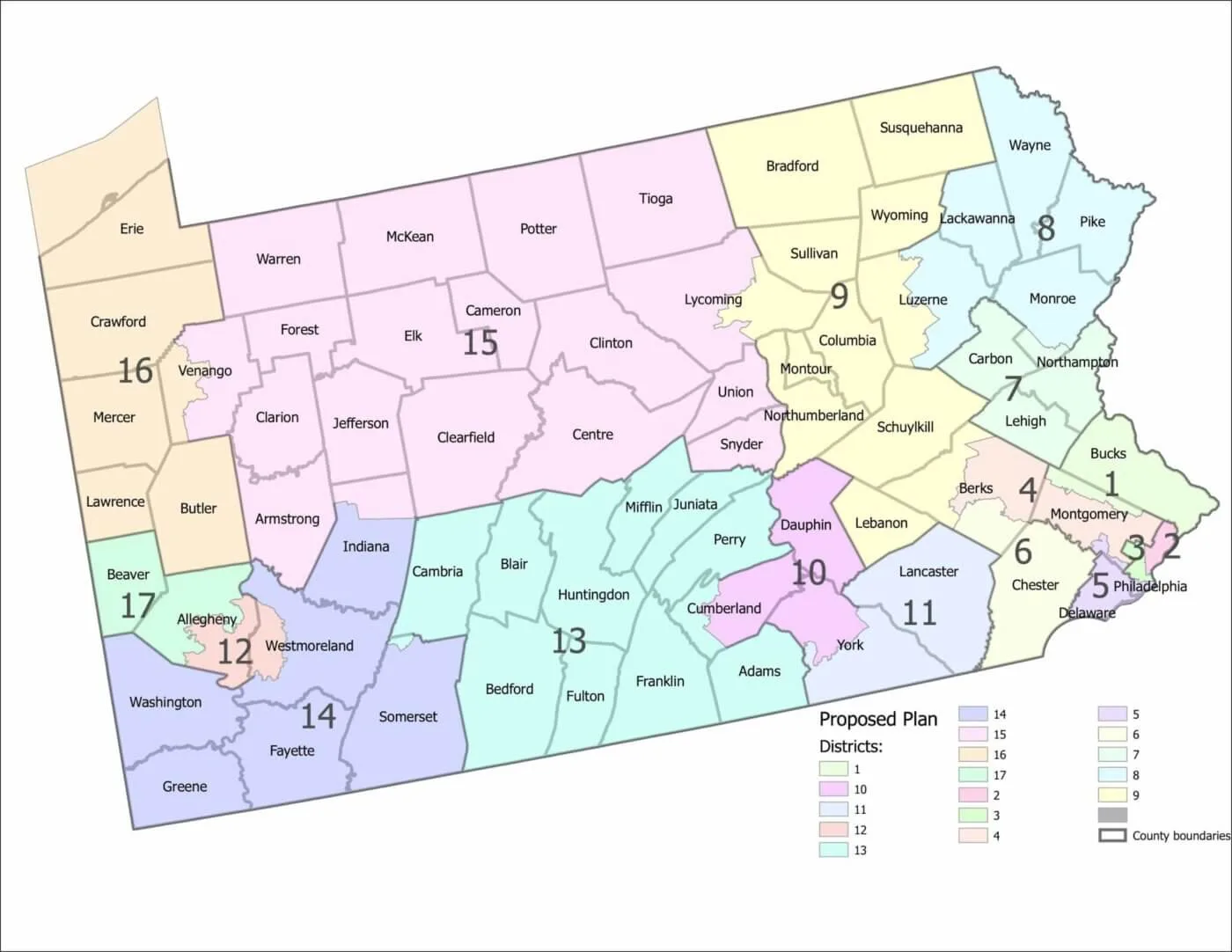
Shown is a new map of congressional districts provided by the Supreme Court Of Pennsylvania on Wednesday, Feb. 23, 2022. Pennsylvania's highest court is breaking a partisan deadlock over a new map of congressional districts by selecting boundaries that broadly adhere to the current outlines of the state's districts. (Supreme Court Of Pennsylvania via AP)
According to analysis, the new 17-district map gives Pennsylvania eight Republican-leaning districts, six Democratic-leaning districts, and three highly competitive districts.
Following partisan deadlock, challenges, and lawsuits, Pennsylvania finally has a new congressional district map.
In a 4-3 vote, the Democratic-majority state Supreme Court selected a 17-district congressional map Wednesday—known as the “Carter Plan”—that had been proposed by a group of Democratic-aligned voters who sued last year in an effort to get the court involved.
Pennsylvania’s congressional delegation lost a seat in the US House of Representatives, going from 18 to 17 due to slow population growth. Pennsylvania has had 18 representatives in the US House for the last decade, down from 19 in the previous decade. The districts have been split evenly between Republicans and Democrats since they were redrawn by the state Supreme Court in 2018 in response to partisan gerrymandering by Republicans.
The new 17-district map gives Pennsylvania eight Republican-leaning districts, six Democratic-leaning districts, and three highly competitive districts, according to analysis by the website FiveThirtyEight.
President Joe Biden would have won nine of the new districts in 2020’s presidential election, while Donald Trump would have won eight, according to an analysis by the website Redistricting & You.
The map keeps the city of Pittsburgh in one district, helping maintain a favorable district for Republicans in its suburbs, and it keeps all of Bucks County in one district, helping protect Republican US Rep Brian Fitzpatrick.
For Democrats, the map ensures each incumbent has their own district and it keeps the metropolitan Harrisburg area in one district with the city of York, instead of splitting it into several districts, as Republicans had sought.
With the congressional map set, the three-week window for potential US House candidates to garner enough petition signatures to get on the primary ballot will now begin Friday and run through March 15. The May 17 primary date remains intact.
Pennsylvania’s new state legislative maps are being held up by a Republican challenge, prompting the court to suspend the primary election calendar for legislative candidates. The majority-Democratic Legislative Reapportionment Commission approved new maps for Pennsylvania’s House and Senate districts earlier this month in a 4-1 vote.
Information from the Associated Press was used in this report.
Politics

New Biden rules deliver automatic cash refunds for canceled flights, ban surprise fees
In the aftermath of a canceled or delayed flight, there’s nothing less appealing than spending hours on the phone waiting to speak with an airline...

Breaking down IVF: What it is and why it’s important in the fight for reproductive rights
In vitro fertilization, or IVF, has been at the forefront of a major reproductive rights battle, but what exactly is it? For many Americans, in...

Fetterman introduces bill to protect affordable internet access for 23 million households
The Affordable Connectivity Program expired on Tuesday due to Republican opposition, putting affordable high-speed internet access at risk for 23...
Local News

Vinyl enthusiasts rejoice: 10 great Pennsylvania record stores to visit on Record Store Day
Highlighted by extremely limited releases, big sales, and in-store performances, Record Store Day returns Saturday and many Pennsylvania shops are...

Look out, Sheetz, Wawa is officially moving into your territory with Central Pa. expansion
The Delaware County-based convenience store chain broke ground on its first Dauphin County location Wednesday in Middletown, with five more stores...






